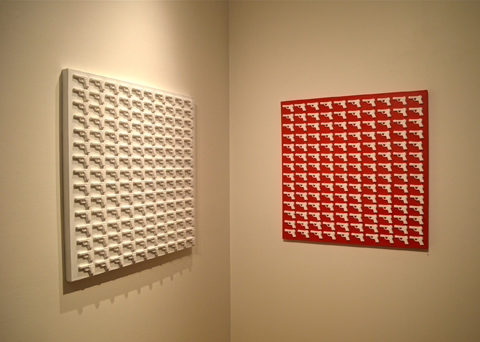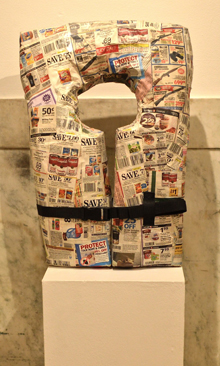
BLUNT Images from the "It Doesn't Show . . ." series. |
“The racism, particularly how it affects black and brown people, it’s devastating,” artist Nafis White says. “And it makes me angry. Even as a woman and a black woman in Providence, I am profiled. The whole situation is infuriating.”
She was telling me how she and her partner, fellow Rhode Island School of Design student Garcia Sinclair, “had been talking at length about Trayvon [Martin]’s murder.
“We were just so affected by that kind of violence, by the continued mass incarceration, mass profiling of people,” says White, who has had brothers in and out of the prison system. “And the subsequent murder of Renisha McBride just added. We’re like, ‘God, we’ve got to talk about that.’ ”
So they rounded up two other RISD students and one alum to join them in the exhibition “It Doesn’t Show Signs of Stopping” at AS220’s Project Space (95 Mathewson St, Providence, through December 28). It’s a good grouping that hums with energy. They asked the artists to “talk to us about your experiences and what you can create that has to do with otherness.”
Sinclair says the Trayvon Martin trial left her feeling “definitely angry, definitely disquieted, definitely fearful. . . Being a queer person living in San Francisco for a long time, you hear about the murders that go on because of different types of profiling.”
“It breeds such a fear that you don’t belong anywhere. Everything you thought you could do in this country and live peaceably is a farce and a lie,” White says. “It is a grief, a betrayal. And betrayed on such a high level. And decades and generations of these memories.”
Doreen Garner taps into that legacy of hurt in All Black, a sad-eyed photo self-portrait of the nude African-American artist in blackface. She wears an elephant trunk for a nose that connects to a sculpture of a large black penis that is part of the picture’s ornate frame. It’s a critique about black people being caricatured as sexual beasts.

RETAIL RESCUE? Sinclair's life vest covered with coupons. |
But its bluntness can make it easy to quickly pass it by because such real, serious problems can feel so familiar and so impossible to even begin to address. A number of works here similarly have righteous subjects, but falter because of too obvious symbolism — Quintin Rivera Toro’s
Ma Grillz of teeth cast in bronze; White’s It
Doesn’t Show Signs of Stopping series of grids of plaster handguns; and Sinclair’s paper life vest covered with coupons for medical marijuana, rifles, “tactical” knives, yogurt, soup, deodorant.
It’s too easy to acknowledge the problems referenced and quickly return to our status quo. Can art get us to pause, to feel the outrages afresh, to try new approaches toward justice?
The loud directness that activists use to call out problems on the streets can feel like a bludgeoning scream inside the resolutely polite art world. Instead many artists turn to conceptual art, but it’s not a reliable approach because, as is the case of some art here, it favors a neutral affect and likes to bury messages behind obscure references that rely on annotation by curators for most viewers to begin decipher.